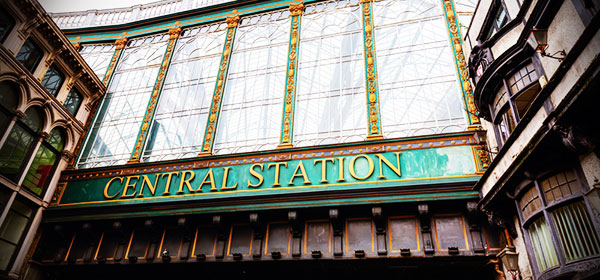One of the many highlights of our recent trip to Scotland was a guided tour of the beautifully preserved Glasgow Central Station. Opened as its headquarters in 1879, by the then Caledonian Railway, it recalls the height of the intense competition between rival railway companies. Somewhat reminiscent of St Pancras in London, this bustling railway terminus is located in the very heart of the city’s CBD and, despite its age, remains a very busy transport hub.
However, as with the proverbial iceberg, if you’re impressed with the gleaming, surprisingly clean, and well maintained above ground station, it’s what hides beneath your feet that is the real eye-opener.
As a devotee of all things rail, one couldn’t pass up the opportunity of joining a guided tour of this grand old lady of rail transport. And it’s particularly accessible when you’re a privileged guest at the Central Hotel, which literally forms the north-east corner of the station building, so you can walk directly onto the station concourse from the hotel foyer. Ah, another reminder of St Pancras. Those clever Victorians and their railway hotels.
So, after an excellent breakfast, a dozen intrepid souls assembled at the information bureau in the centre of the concourse, where we meet Paul Lyons who’s to be our guide. A strikingly tall, slim gentleman with an engaging manner and evil sense of humour all delivered in a beguiling Scots accent. After the obligatory safety briefing and the somewhat amusing donning of ubiquitous high-vis vests and orange hard hats, we descend to the levels below.
Apparently, when the tours commenced in late 2014, they included a walk above the impressive and expansive glass roof spanning all 15 platforms. Covering 2.2 square miles and consisting of 48,000 individual glass panes, it is one of the largest in the world. During WWII it was painted black in the hope of escaping enemy attention. This simple ruse worked, but the black paint proved too tenacious to remove, so in the late 1990s every pane had to be replaced.
However, today our group is descending rather than ascending. With the assured confidence of a man who has spent his life around trains and the last two decades at this particular location, Paul shepherds us downstairs and into an amazing network of brightly illuminated barrel-vaulted ‘spaces’. The walls are freshly painted and the motor vehicles are dwarfed by the height of these brightly lit ‘tunnels’. As we progress along this level, the passages narrow – now only wide enough for pedestrians – and the ceilings are lower. Everything is constructed from bricks and one wonders how many millions of bricks it took these late Victorian brickies and labourers to complete such a labyrinthine expanse.
Paul provides a running commentary as we progress and his passion for his subject matter is palpable. Always happy to answer questions, none of our group seems able to catch him out. I find myself torn between staying as close to our guide as possible, in order to catch every gem of history and humour, and the need to photograph every detail of this hidden, subterranean world. But if you linger for more shots, you need to keep an eye on where the group goes. Paul sets a steady pace, so woe betide the stragglers!
We do, however, pause at various significant sites such as the temporary WWI morgue and clearing station where the bodies of those killed, in the mass carnage of the Western Front, were deposited. Despite the bright lights and freshly painted walls, this is a very gloomy space, with poignant reminders of one hundred years ago – an ancient wheelchair for the seriously wounded and old canvas stretchers propped against a wall. Paul explains that the families of these soldiers had to come and collect both the living and the dead.
As we progress through more passages and doors, we learn how the entire village of Grahamston was razed to clear this site for the station. Also, that the night mail train to London, subject of the ‘Great Train Robbery’, departed from Glasgow Central. And, thankfully, that the giant rats that once infested these lower galleries and passages, attracted by the grain and other goods stored here, have not been seen recently. This from our guide, who enigmatically smiles as he shares this startling news.
One suspects Paul deliberately saved the best to last, taking us through a particularly torturous route to what feels like the lowest level of the entire, vast station complex. Now armed with a powerful torch, our guide illuminates an almost totally black space where the old Victorian platforms stand idle, apparently from when they ceased operations thanks to Dr Beeching in the 1960s. The original massive cast-iron pillars, in turn supporting equally impressive cast-iron beams, bear testimony to the quality workmanship of Victorian engineers. The total ‘blackness’ is a legacy from when these platforms were serviced by steam engines, which Paul hopes to recreate in the future and include in the tours.
We emerge back into broad daylight, into the 21st century and the bustling concourse traversed by 29 million passengers annually. As we return our vests and hard hats, thanking Paul for what has been an exceptional tour, my head is still spinning from the underground world we have just left. So much history and, apparently, there’s still more to be unearthed. I feel truly privileged to have had the opportunity to take this tour led by such a passionate and amusing railway history buff. Little wonder that Trip Advisor rates these tours as ‘Glasgow’s number one’!
Glasgow Central Station Tour
- Approximately 90 minutes
- Cost £10 (in September 2017)
- For more information: www.glasgowcentraltours.co.uk
David Fallick enjoyed this tour courtesy of People Make Glasgow.
Related articles:
David’s dream rail tour
People make Glasgow
Top tips for European train travel

